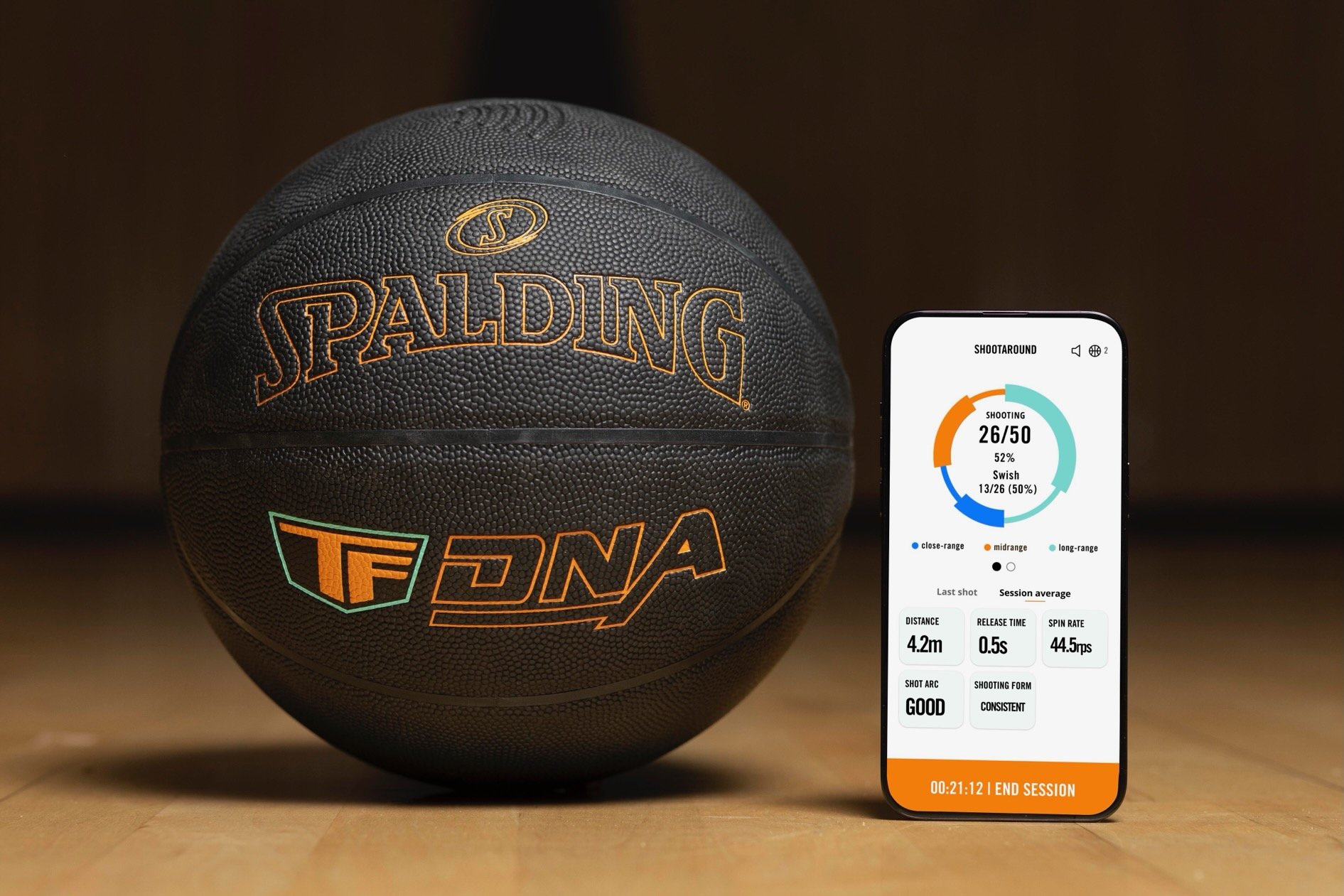Finnish sportstech startup SportIQ, the producer of smart basketballs and shooting data software, has been selected for the NBA Launchpad program for 2025.
Founded in 2017 by serial entrepreneur Harri Hohteri, the startup sold its first smart basketball in 2020, and the company has since sold over 20,000 Spalding smart balls, which retail for $159, including a one-year subscription.

I spoke to CEO Erik Anderson to find out all about it.
SportIQ has developed a smart basketball with over 25 patents for recreational sports enthusiasts. It contains internal sensors, including a 9D sensor and AI technology, that track various aspects of each shot. The ball tracks 192 data points per shot and feeds data about shooting position, power, angle, and technique, amongst other things, to the mobile app, which then uses AI technology to analyse the data and give players direct feedback on improving their performance.
According to Anderson:
"Activating the ball is simple — just spin it to wake up the battery. The system instantly tracks and displays real-time data, including release speed, shot distance, and spin rate. If a shot is a swish, we detect that too."
AI and machine learning is at the core of the company's technology, and Anderson details that the company has analysed millions of shots.
Its main patent covers all recreational projectiles that track AI or ML events via radio frequency. While simply measuring spin doesn't fall under this patent, tracking key metrics like shot accuracy does.
"Our technology enables us to train algorithms to recognise and analyse different events. In basketball, for example, we need to distinguish between a pass and a shot — two actions that can appear very similar. We've developed an algorithm that accurately identifies whether an action is a pass or a shot.
Once connected to our app, the smart ball provides real-time analytics. As long as there's a net on the hoop, our AI-powered algorithms, trained to 99.9 per cent accuracy, can determine whether a shot was made or missed. Imagine a kid shooting in their backyard — our system can track that they took 100 shots and made 65."
Beyond simple shot tracking, SportIQ gamifies basketball, creating custom challenges, like making as many shots as possible from beyond 15 feet in 100 seconds. Its distance algorithm allows it to create leaderboards where players can see how they rank, fostering engagement and competition.
To date, SportIQ has already tracked over 20 million shots, helping players improve their shooting accuracy by 15 per cent with regular use.
Anderson shared:
"It's incredible to watch the numbers grow—kids are taking thousands of shots in just a week, all while balancing school and other activities.
Our system also provides a progress bar, allowing players to track their improvement over time. They can review past sessions and analyse key metrics such as close-range, mid-range, and long-range accuracy, average release time, spin rate, and shot consistency. If a player's arc is too low or their shot is inconsistent, our AI provides personalised drill recommendations to help them improve."
Each ball has a service life of 500 hours - you can shoot for 1.5 hours every day for a year.
From a business perspective, SportIQ is unique in that it started with a consumer product, representing the largest sports market.
The company first aimed to scale to the US at speed — at its inception, Finland had around 17, 000 registered basketball players compared to 30 million players in North America currently.
Further, Anderson asserts:
"If we had only focused on the professional level— NBA, some colleges, and maybe the EuroLeague — we'd be targeting a relatively small market. While that could generate a few million in annual revenue, the addressable market is limited, the sales cycle is long, and precision is critical."
In contrast, the consumer market includes hundreds of millions of basketball players worldwide who would benefit from a smart ball. Youth sports, in particular, represent the biggest opportunity in the industry. However the professional sports market not only opens up avenues to test the tech to its limits but also add exposure to millions of sports enthusiasts.
In this six-month NBA launchpad, the startup will have hands-on support and access to the NBA's resources to develop its technology further, culminating in SportIQ presenting its developments to NBA executives, partners, and investors during the NBA Summer League 2025.
The NBA is seeking technologies that can improve call accuracy, streamline the viewing experience, and increase decision-making transparency with an emphasis on finding new sensing modalities (e.g., cameras, IMU, LiDAR, radar, depth sensors, ultrasonic sensors) and AI/ML software tools to assist with model development, and 3D visualisation engines to recreate plays from the data.
According to Anderson, the company is manufacturing and integrating the hardware directly into NBA basketballs.
"Since these are standard game balls with embedded technology, we need to consider all logistical aspects — including how equipment managers will charge them.
Unlike other tech-driven sports solutions, we won't have dedicated personnel in every gym, so charging stations must be integrated seamlessly."
Beyond hardware, UX is critical; equipment managers will need a streamlined software interface, while game officials must be able to select and connect a ball for the entire duration of a game without interruptions. The startup also needs to build and install antennas in NBA arenas to ensure seamless connectivity and close to real-time data transmission.
Basketball is just a starting point, as SportIQ's sensor technology can be fitted into any kind of ball used in recreational and professional sports.
"If all goes well, we are soon ready to expand to new markets and sports," Anderson concludes.
Lead image: Erik Anderson and Harri Hohteri from SportIQ. Photo: uncredited.



Would you like to write the first comment?
Login to post comments